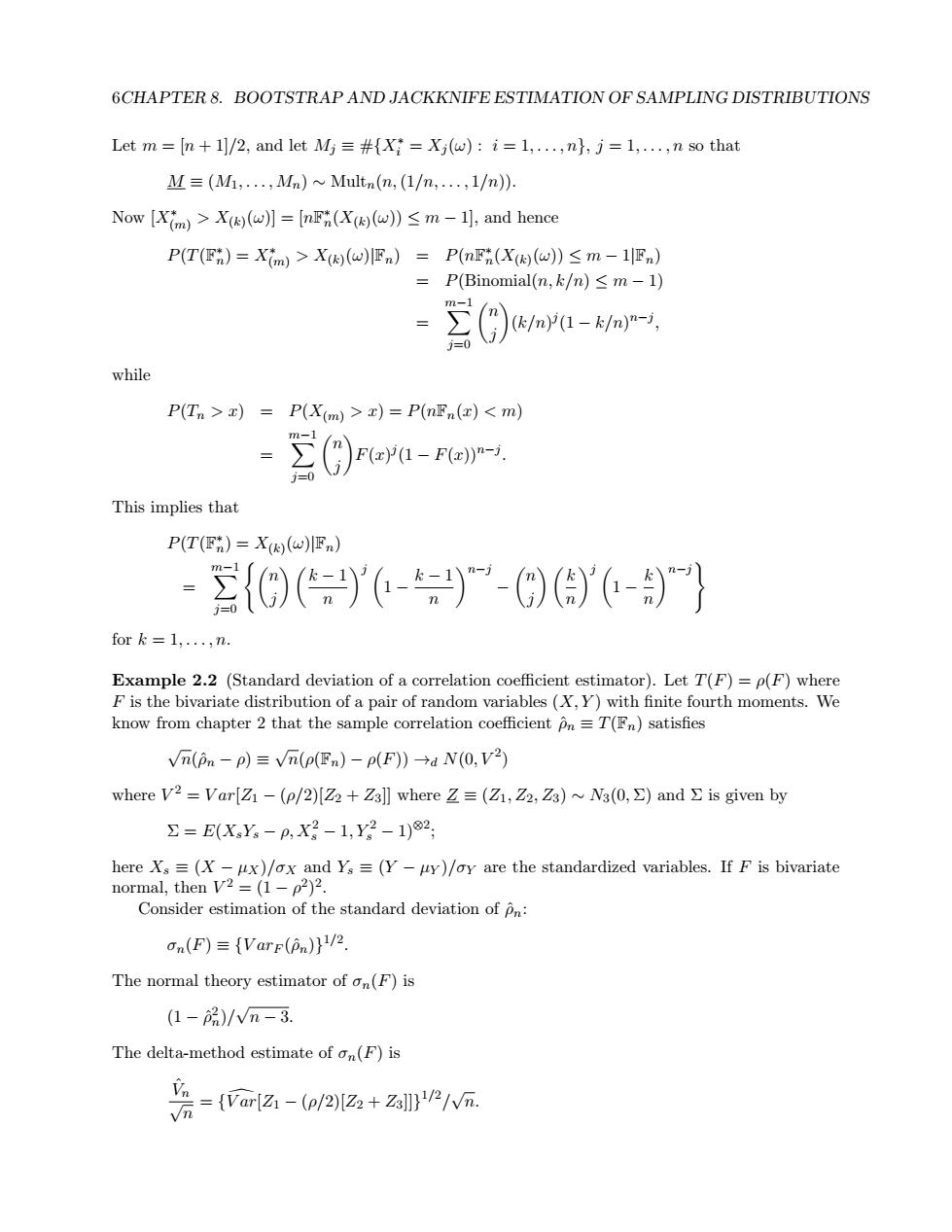正在加载图片...

6CHAPTER 8.BOOTSTRAP AND JACKKNIFE ESTIMATION OF SAMPLING DISTRIBUTIONS Let m [n+1]/2,and let Mj=#=Xj(w):i=1,...,n},j=1,...,n so that M=(M,...,Mn)~Multn(n,(1/n,...,1/n)). Now[Xim)>X((a]=[nF(X(k)(u)≤m-,and hence P(T(F克)=Xtm>X((o)lFn)=P(n(X((a》≤m-1Fn) P(Binomial(n,k/n)<m-1) while P(Tn >x)=P(X(m)>2)=P(nFn()<m) ()eom-ra This implies that P(T(F)=X(k)(w)Fn) for k 1,...,n. Example 2.2 (Standard deviation of a correlation coefficient estimator).Let T(F)=p(F)where F is the bivariate distribution of a pair of random variables (X,Y)with finite fourth moments.We know from chapter 2 that the sample correlation coefficient n =T(Fn)satisfies vn(pn-p)≡vn(p(Fn)-p(F)→aN(0,V2) where V2=Var[Z1-(p/2)[Z2+Z3]]where Z=(Z1,Z2,Z3)~N3(0,>and is given by 2=E(XY-p,X-1,y2-1)82: here Xs =(X-ux)/ax and Ys =(Y-uy)/oy are the standardized variables.If F is bivariate normal,then V2 =(1-p2)2. Consider estimation of the standard deviation of pn: on(F)=Varr(pn))112. The normal theory estimator of on(F)is (1-2)/vn-3. The delta-method estimate of on(F)is =(Var(z -(p/2)+6CHAPTER 8. BOOTSTRAP AND JACKKNIFE ESTIMATION OF SAMPLING DISTRIBUTIONS Let m = [n + 1]/2, and let Mj ≡ #{X∗ i = Xj (ω) : i = 1, . . . , n}, j = 1, . . . , n so that M ≡ (M1, . . . , Mn) ∼ Multn(n,(1/n, . . . , 1/n)). Now [X∗ (m) > X(k) (ω)] = [nF ∗ n (X(k) (ω)) ≤ m − 1], and hence P(T(F ∗ n ) = X∗ (m) > X(k) (ω)|Fn) = P(nF ∗ n (X(k) (ω)) ≤ m − 1|Fn) = P(Binomial(n, k/n) ≤ m − 1) = mX−1 j=0 n j (k/n) j (1 − k/n) n−j , while P(Tn > x) = P(X(m) > x) = P(nFn(x) < m) = mX−1 j=0 n j F(x) j (1 − F(x))n−j . This implies that P(T(F ∗ n ) = X(k) (ω)|Fn) = mX−1 j=0 ( n j k − 1 n j 1 − k − 1 n n−j − n j k n j 1 − k n n−j ) for k = 1, . . . , n. Example 2.2 (Standard deviation of a correlation coefficient estimator). Let T(F) = ρ(F) where F is the bivariate distribution of a pair of random variables (X, Y ) with finite fourth moments. We know from chapter 2 that the sample correlation coefficient ˆρn ≡ T(Fn) satisfies √ n(ˆρn − ρ) ≡ √ n(ρ(Fn) − ρ(F)) →d N(0, V 2 ) where V 2 = V ar[Z1 − (ρ/2)[Z2 + Z3]] where Z ≡ (Z1, Z2, Z3) ∼ N3(0, Σ) and Σ is given by Σ = E(XsYs − ρ, X2 s − 1, Y 2 s − 1)⊗2 ; here Xs ≡ (X − µX)/σX and Ys ≡ (Y − µY )/σY are the standardized variables. If F is bivariate normal, then V 2 = (1 − ρ 2 ) 2 . Consider estimation of the standard deviation of ˆρn: σn(F) ≡ {V arF (ˆρn)} 1/2 . The normal theory estimator of σn(F) is (1 − ρˆ 2 n )/ √ n − 3. The delta-method estimate of σn(F) is Vˆ n √ n = {V ar d[Z1 − (ρ/2)[Z2 + Z3]]} 1/2 / √ n